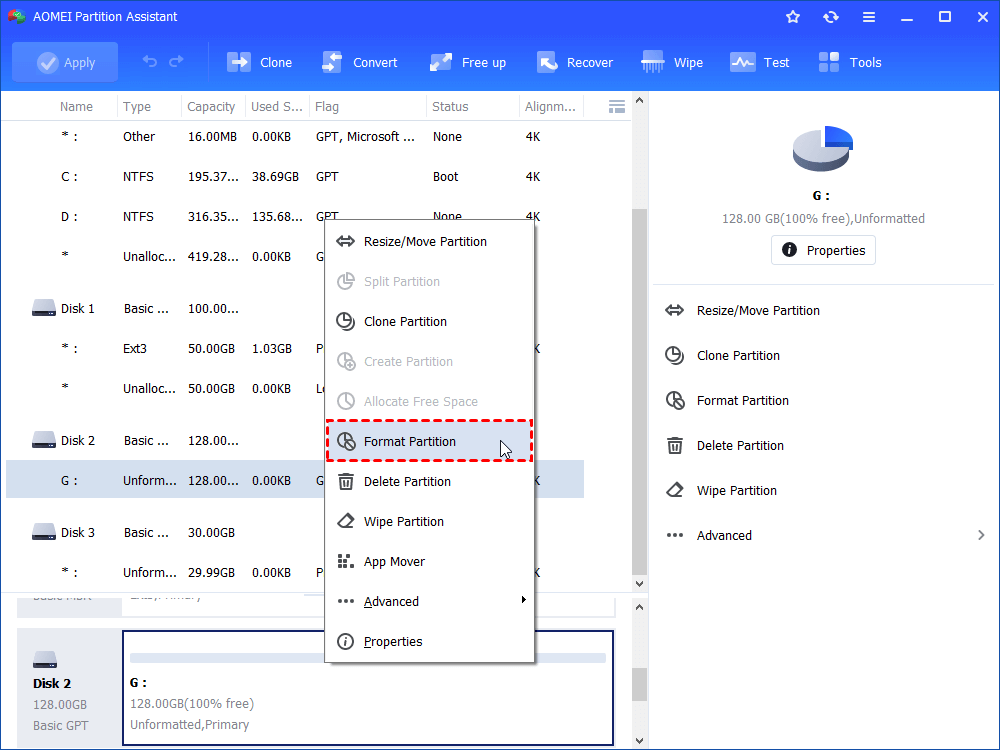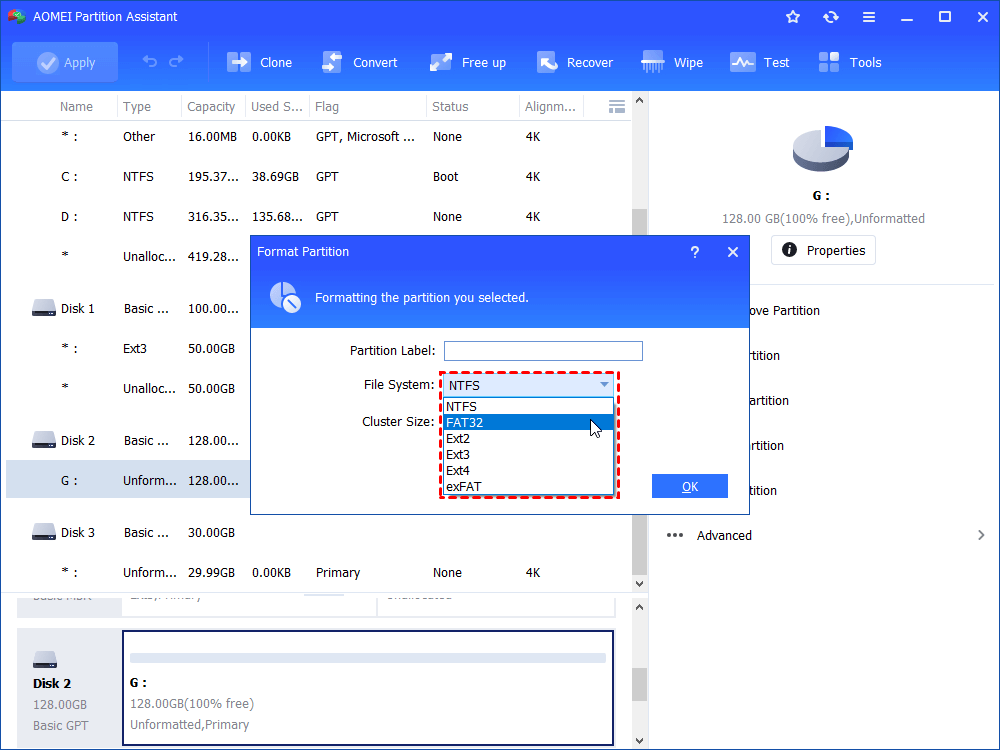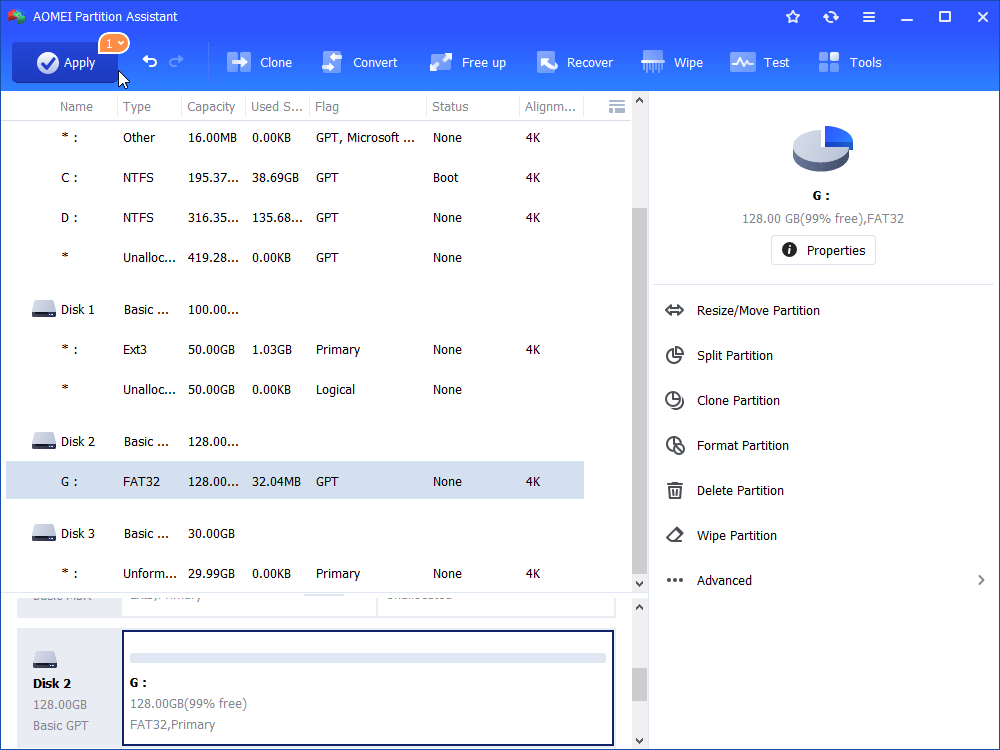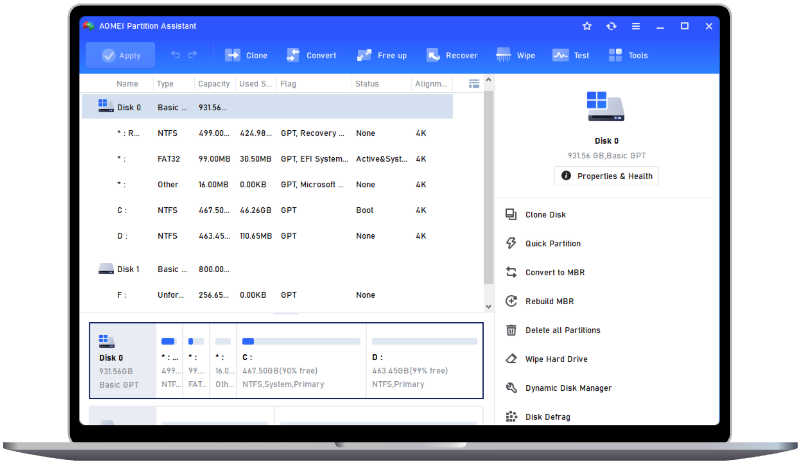6 Ways to Fix You Need to Format Disk in Drive Error
Have you ever encountered the "You need to format the disk in drive" error? Don’t worry, this article will explain the most possible reasons for it and provides six effective methods to fix you need to format disk in drive error.
What does "You need to format the disk in drive" mean?
External storage devices, such as USB drives, are essential for transferring files between computers due to their large capacity and portability. However, they can sometimes cause issues. For instance, you might encounter an error when connecting an external hard drive to your PC, preventing access through File Explorer. The message typically reads: "You need to format the disk in drive F: before you can use it. Do you want to format it?" (Note that the drive letter may vary). In Disk Management, the drive's file system may show as RAW instead of the usual NTFS or FAT.
This error usually occurs when Windows is unable to properly recognize or read the drive, suggesting that its file system is either corrupted or unsupported. As a result, accessing the drive or its data becomes impossible without formatting it.
Such an issue can happen with any external storage device, including hard drives, USB flash drives, pen drives, or memory cards. When the error appears, you're typically presented with two options: Format Disk or Cancel.
If the data on the drive is valuable, you understandably want to avoid formatting it. Formatting a drive erases all existing data and prepares it for a new file system. The best course of action is to close the dialog box and refrain from formatting. On the following page, you'll find clear instructions on how to recover data and resolve this error with ease.
Why do I need to format the disk in drive?
Before exploring solutions, it's important to understand the potential causes of this error. By identifying the root cause, you can better protect your drive from similar issues in the future. When a partition prompts you to format it, this typically indicates that the drive's file system is either corrupted or not recognized by your operating system. Here are some common reasons why this error occurs:
1. File system corruption: If the file system of a partition becomes damaged or corrupted (e.g., the drive is marked as RAW), Windows will be unable to read it. Typically, the only solution is to format the drive, which is why you see the error message.
2. Bad sectors: Physical issues with the drive, such as bad sectors or a failing disk controller, can render the drive inaccessible. These hardware problems can prevent the system from reading the drive, leading to the formatting error.
3. Corrupted partition table: The partition table, which holds information about the disk's partitions and their locations, can become corrupted. If the operating system cannot locate the valid partitions, it may prompt you to format the drive to recreate the partition table.
4. Virus infection: Malware or other malicious software can target and damage the file system or partition structure, rendering the partition unreadable and triggering the format prompt.
5. Unsupported file system: If the drive is formatted with a file system that Windows doesn't support, such as EXT2, EXT3, or EXT4, the system will be unable to read it and will suggest formatting the disk.
Understanding these causes can help you take proactive measures to protect your external drives from future errors.
How do you fix you need to format the disk in drive error?
We have compiled a comprehensive list of effective solutions to resolve the 'You need to format the disk in drive before you can use it' error.
Solution 1. Verify hard disk connection
First, ensure all cables and connections between the drive and your computer are securely attached, as loose connections can sometimes trigger errors. The issue might also lie with the USB port, cable, or even the computer itself. Try the following steps to troubleshoot:
Step 1. Connect the external drive to a different USB port on your PC and check if the error persists.
Step 2. Try plugging the external drive into another computer to see if it's accessible.
Step 3. Test the drive on a different operating system, such as macOS or Linux, to determine if the issue is specific to Windows.
Step 4. If the error appears after switching to a new HDD enclosure, there could be an incompatibility issue. Try using a different enclosure or connect the drive directly to the motherboard.
Solution 2. Check If the Disk Is Recognized by the System
For your operating system to access the drive, it must have a compatible file system and the correct storage capacity. To check if your computer is detecting the drive, you can use Disk Management.
Follow these steps to see if the drive showing the ‘You need to format the disk before use’ error is recognized by your system:
Step 1. Right-click the Start button and select Disk Management.
Step 2. Look for the drive in Disk Management. Check if it shows a recognizable file system and if the storage capacity matches the drive’s specifications.
Step 3. If the drive is visible and displays the correct storage capacity, you can attempt repairs using one of the solutions listed below. However, if the drive doesn't appear or shows the wrong storage size, it's advisable to consult a data recovery service for professional assistance.
Solution 3. Check and repair bad sectors for the drive
CHKDSK is a file system repair tool that can help identify and fix errors on the drive. Running it via Command Prompt (CMD) may resolve the issue causing the error message. Here's how to run CHKDSK:
Step 1. Press “Windows” + “R” to open the Run box, typing “cmd” in it and press “Enter”.
Step 2. In the terminal window, type chkdsk C: /f /r, replacing the asterisk (C) with the letter assigned to your drive.
Step 3. CHKDSK will begin scanning the drive for errors and attempt to repair them.
Solution4. Scan the hard drive for viruses
Malware is a persistent threat on the internet, and if your drive is infected, it could be the cause of the error message. To remove any viruses, you can use built-in antimalware software like Microsoft Defender Antivirus, which is free and comes with Windows 10 and 11.
Here’s how to scan for viruses using Microsoft Defender Antivirus:
Step 1. Open File Explorer.
Step 2. Shift-right-click on your drive and select Scan with Microsoft Defender.
Step 3. For a more thorough scan, choose Microsoft Defender Offline Scan and click Scan now to perform an offline scan.
Solution 5. Update drivers
Drivers play a vital role in ensuring proper communication between your device and the operating system. If they are corrupted or outdated, it can affect your drive's readability. Updating the drivers for your internal or external hard drive might be all that's needed to resolve the issue.
Here’s how to update your drive’s drivers:
Step 1. Right-click the Start button and select Device Manager.
Step 2. Expand Disk Drives, then right-click your drive and choose Update driver.
Step 3. Select Search automatically for drivers to allow Windows to search for and install the latest drivers.
Solution 6. Format the disk in the drive
Formatting the disk will erase all data, so be sure to back up any important files before proceeding. If the previous solutions didn’t resolve the issue, formatting the drive might be necessary. Here's a quick guide to formatting the partition:
Step 1. Press “Windows+R” and input “diskmgmt.msc” in the run window.
Step 2. Locate the drive that you cannot open, right-click on it, and select Format from the context menu.
Step 3. Choose the appropriate file system for your needs and click OK.
Step 4. Confirm the formatting by clicking Yes, and the drive will be formatted immediately.
If you need to format a drive larger than 32GB to FAT32, or are dealing with a RAW, write-protected, or corrupted disk, the previous methods may not be sufficient.
In such cases, a reliable third-party formatting tool is a better option. AOMEI Partition Assistant is a professional disk and partition manager designed for Windows 11/10/8/7usersto avoid the partition size limit.
With just a few clicks, you can format any type of disk into your preferred file system, including NTFS, FAT32, exFAT, EXT2, EXT3, and EXT4. Beyond formatting, this tool also offers features such as disk cleaning and hard drive wiping, making it a versatile solution for disk management.
Step 1. Install and run it. Locate the disk that needs formatting, right-click it and choose Format Partition.
Step 2. It will prompt a window where you can set the files system of the partition. If you need, you can add partition label to or change cluster size of the partition.
Step 3. Review the operation. Click Apply and Proceed if you are satisfied.
Conclusion
In this guide, we’ve outlined the steps to take when your USB or external drive prompts you to format it. To avoid similar issues in the future, always use the Safely Remove Hardware and Eject Media option before unplugging a removable disk. Additionally, it’s recommended to recover your data after formatting the drive or running disk checks.





